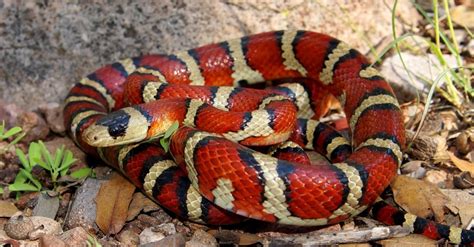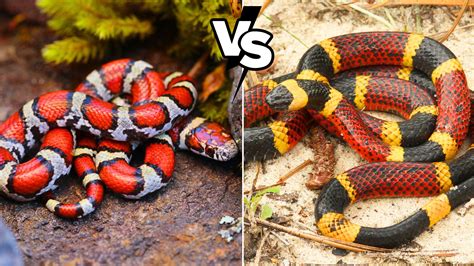kingsnake vs coral snake ,coral vs milk snake,kingsnake vs coral snake, Knowing how to tell apart coral snakes from king snakes isn’t just fun—it’s potentially life-saving. Both critters flaunt flashy colors, but the coral snakes pack a toxic punch, unlike the more user-friendly king snakes. Let’s . The reference 16800 Submariner was first released in 1978 as an update to the reference 1680. It remained in production for a full decade until it was later replaced by the .

When it comes to identifying snakes, particularly in North America, many people often confuse kingsnakes with coral snakes. Both species are known for their striking color patterns, which can easily be mistaken for one another, especially by those without expertise in herpetology. However, despite the similarities in coloration, kingsnakes and coral snakes have a number of key differences, both in terms of appearance, behavior, and venomous capabilities. Understanding these differences is essential not only for safety reasons but also for the appreciation of these fascinating creatures.
The 5 Key Differences Between Coral Snakes and Kingsnakes
# 1. Size and Body Shape
One of the easiest ways to distinguish between a kingsnake and a coral snake is their size and body shape.
- Kingsnakes are generally much larger than coral snakes, often ranging from 3 to 5 feet in length, with some species reaching up to 6 feet. Kingsnakes are typically more robust and muscular, with a thicker, more cylindrical body.
- Coral Snakes, on the other hand, are significantly smaller, usually growing to lengths of only 18 to 30 inches. Coral snakes have slender bodies, which are noticeably thinner than those of kingsnakes. Their smaller size can make them less noticeable in the wild, though their brightly colored markings often draw attention.
# 2. Color Patterns and Markings
Both kingsnakes and coral snakes have distinct color patterns, which is why they are often confused by untrained eyes. However, there are key differences in the arrangement and the coloration itself.
- Kingsnakes are generally black or dark brown with alternating bands of white or cream. The color pattern can vary, with some species having more vivid or muted colors, but the primary feature is the alternating bands, which are usually much wider than those of a coral snake. Kingsnakes often have a glossy, smooth appearance, which enhances their striking appearance.
- Coral Snakes have a much more distinct and vibrant color pattern, typically featuring bands of red, yellow (or white), and black. The arrangement of these colors is what often leads to confusion. The famous rhyme “Red on yellow, kill a fellow; red on black, friend of Jack” helps distinguish coral snakes from non-venomous lookalikes. However, it’s important to note that the color pattern on a coral snake is very specific: the red bands touch the yellow bands, while in kingsnakes, the red bands are separated by black or brown.
# 3. Venom: Dangerous vs. Harmless
A critical difference between coral snakes and kingsnakes is their venomous nature. This is one of the most significant distinctions and is the reason why learning to identify these snakes properly is crucial.
- Coral Snakes are venomous and belong to the family *Elapidae*, which also includes cobras, mambas, and sea snakes. Their venom is potent neurotoxic, which means it affects the nervous system. Coral snakes possess small fangs at the front of their mouths, and although their bites are rare due to their shy nature, they can be deadly if untreated. Coral snake venom causes paralysis, respiratory failure, and in extreme cases, death. However, bites from coral snakes are relatively rare because they tend to avoid human interaction.
- Kingsnakes, by contrast, are entirely non-venomous. They are constrictors, meaning they kill their prey by wrapping around it and suffocating it. Kingsnakes feed on a variety of prey, including rodents, birds, amphibians, and even other snakes. Some kingsnakes are known to prey on venomous snakes, including coral snakes. Their immunity to the venom of other snakes, including the coral snake, makes them a key predator in certain ecosystems.
# 4. Behavior and Temperament
While both species can be found in a variety of habitats, including forests, grasslands, and urban areas, their behavior and temperament vary significantly.

kingsnake vs coral snake $5,400.00
kingsnake vs coral snake - coral vs milk snake